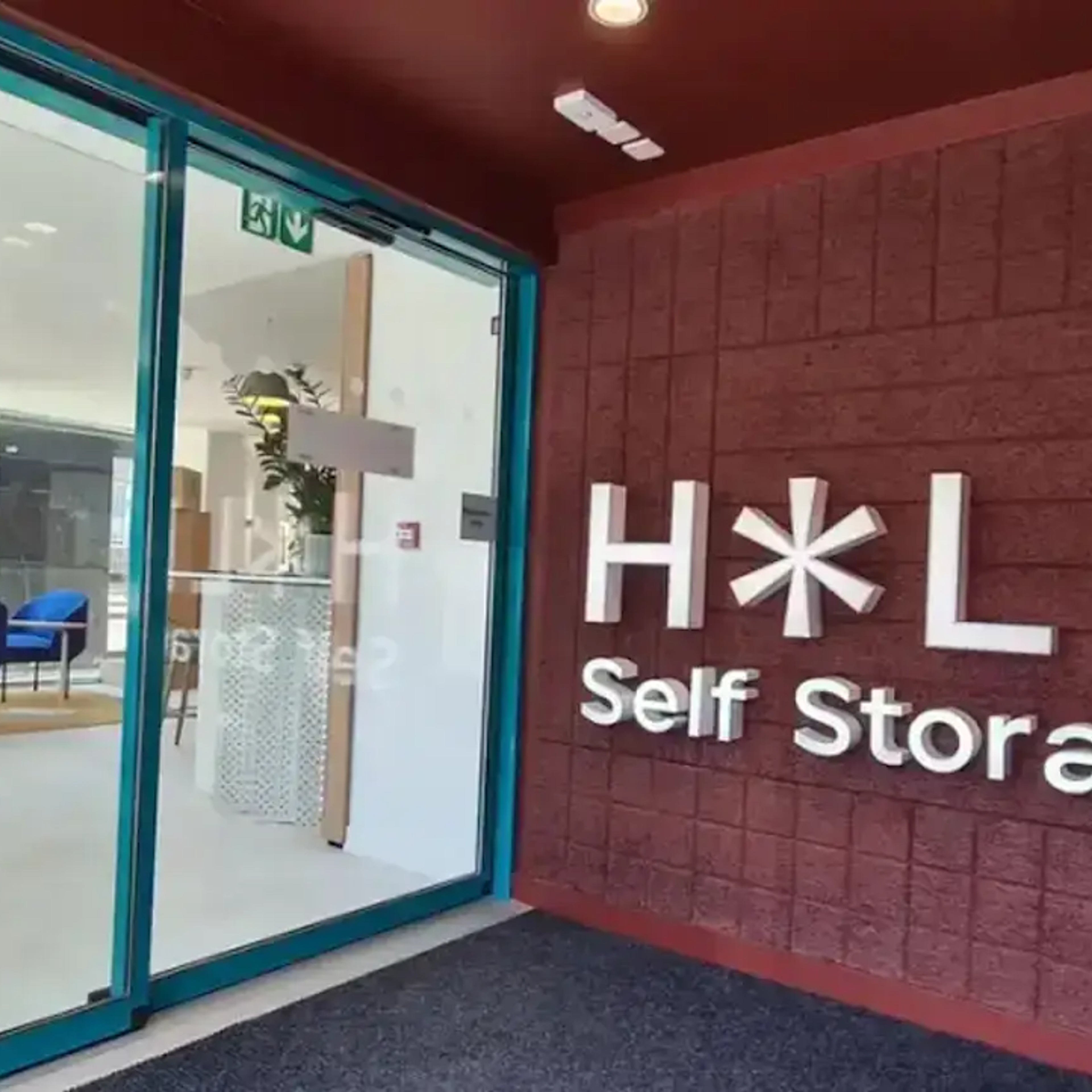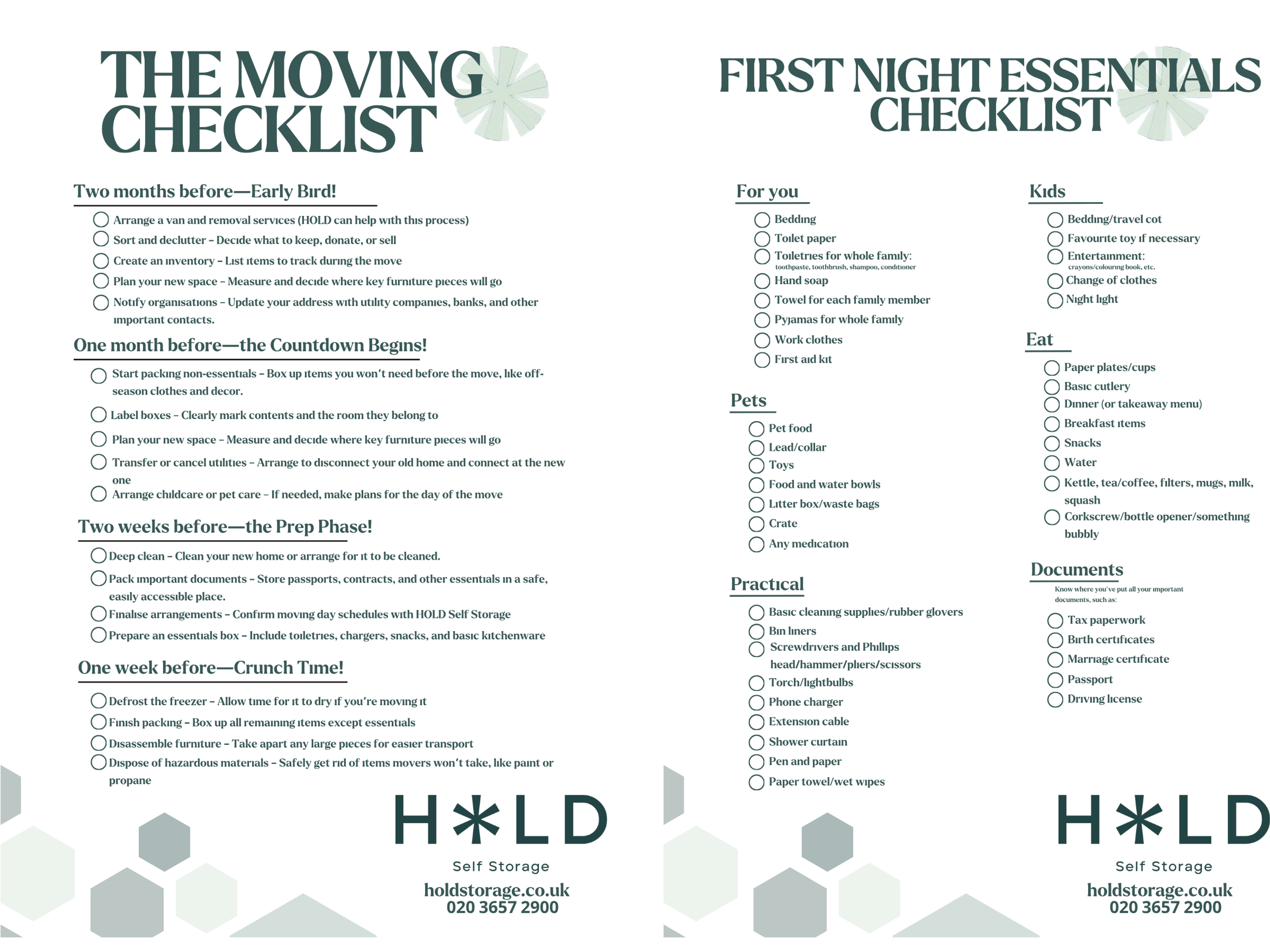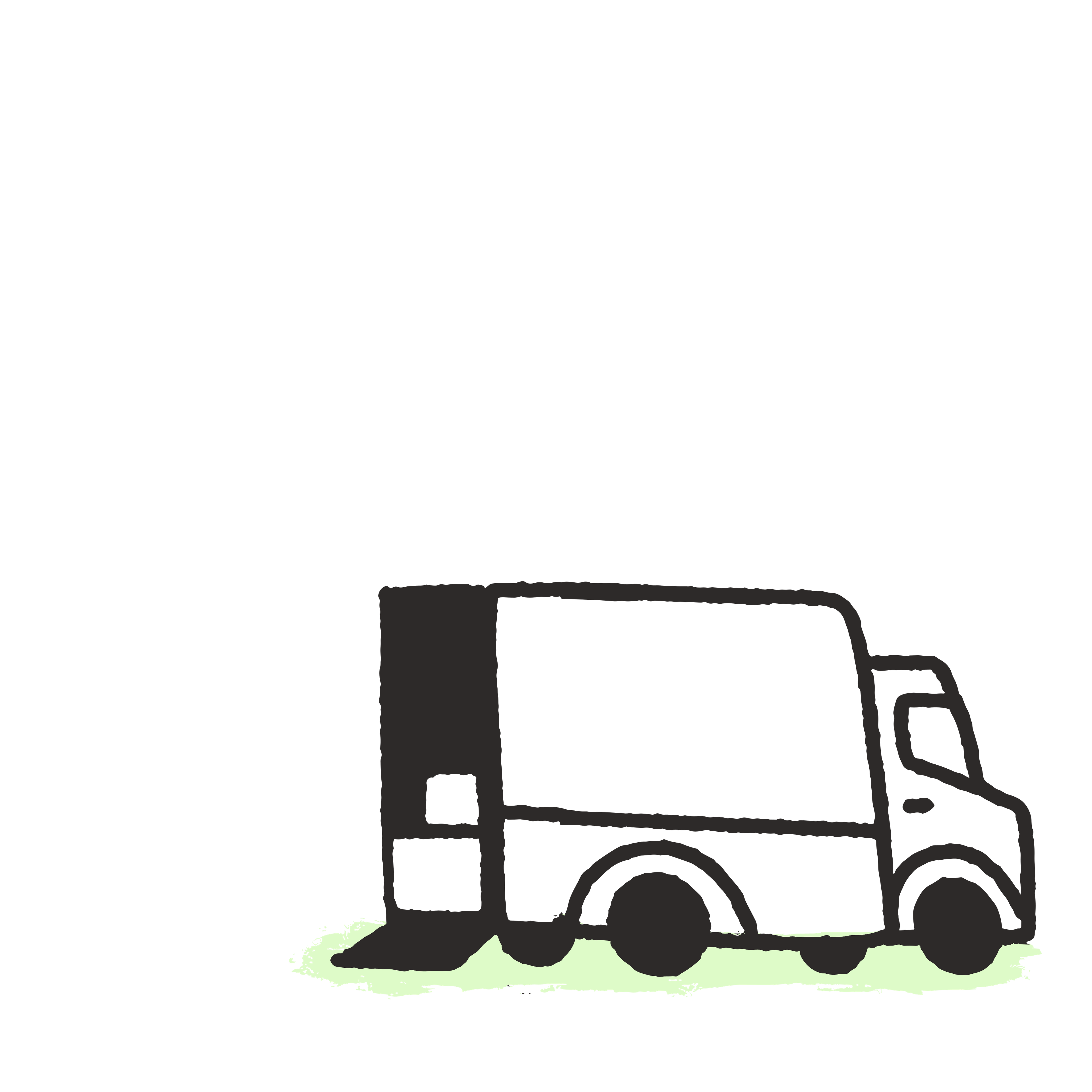A moving house checklist helps you stay organised, avoid last-minute costs, and keep stress to a minimum.
From sorting through years of belongings to setting up services at your new address, moving home comes with a long list of tasks. Getting your ducks in a row will reduce stress and avoid last-minute surprises. Our moving house checklist covers every step, ensuring nothing gets overlooked. With 21 essential tasks to complete, you’ll have a clear roadmap to follow. We’ll walk you through every stage of the moving process, helping you stay on top of everything from packing and paperwork to storage solutions and setting up utilities.

Plan a Stress-Free Move in 2025
1. Submit your notice before moving
Moving house can be a big step. Whether you're a first-time buyer, or on your third transition, it's a good idea to get all your ducks in a row.
The first step is to notify your landlord.
- Check your tenancy agreement (provided by your landlord or estate agent) to ensure you comply with the required notice period and avoid penalties.
- Write a clear notice stating your intent to vacate and the move-out date to legally document your departure.
- Send the notice via recorded delivery or hand it in personally to have proof of the notification date and prevent disputes.
- Discuss the final inspection, deposit return, and any remaining tenancy obligations with your landlord to clarify expectations.
- Keep copies of your notice and all related communications to resolve any potential misunderstandings or legal issues.
2. Set your moving date
Once you exchange contracts and set a completion date, you can start planning your move. Choosing the right date is essential for a smooth moving home experience. To make the process easier, consider these tips:
- Plan your schedule – Select a day that provides ample time for packing, utility meter readings, and notifying financial institutions. This can help avoid delays and ensure you don’t feel rushed.
- Think about school terms – Moving during school holidays is often more convenient if you have little ones, giving them time to settle into the new area without disrupting their education.
- Check weather conditions – Favourable weather can make tasks like loading and unloading smoother, ensuring your belongings—especially fragile ones like important documents—are protected.
- Coordinate early – Confirm the date with your removal firm and notify other relevant parties, such as your estate agent or solicitor, if you’re finalising contracts for a new property.
- Prepare for contingencies – Allow a few hours of buffer time to handle any unexpected challenges, like traffic or last-minute packing.
By carefully planning your big day, you’ll make the transition to your new property more seamless.
3. Budget for the move
Before you start packing, you need to get an accurate estimation of your moving costs. This will help avoid financial setbacks. Budget for expenses such as removal firms, packing materials, and potential additional costs like storage unit fees, insurance, exchange contracts, and pet relocation.
Remember, moving company costs vary. What you ship out depends on the size of your move, the distance travelled, and the going rates in the area. So be sure to compare quotes from different removal companies to obtain an accurate estimate.
When budgeting for packing materials, consider the size of your move and the type of materials you need. Our Box Shop has items like boxes, tape, and bubble wrap at competitive prices, keeping costs low for the big move.
However, specialty items like mattress covers and wardrobe boxes may also be necessary.
Update or arrange home insurance
Included within your budgetary plan should be a review of your current home insurance policy. Ensure it covers your belongings during the transition. If you own your property, check that your buildings insurance remains valid and update it with your new address details.
For renters, verify that your landlord’s policy covers structural issues so you can focus solely on home insurance for your personal belongings.
If your home insurance doesn't cover items in transit, consider arranging temporary moving insurance to protect against potential damage or loss.

4. Declutter
- Start early – Begin decluttering several weeks in advance to avoid last-minute stress.
- Categorise items – Organise belongings into categories such as keep, sell, donate, and discard.
- Use the one-year rule – If you haven’t used an item for a while, and it doesn’t hold sentimental value, consider letting it go.
- Plan a declutter day – Set aside specific days for different areas of your home (garage, attic, closets, etc.)
- Sell or donate – Sell items of value online or at a garage sale. Donate items to a charity or give them to friends and family.
- Be decisive – Avoid returning items once you’ve decided to part with them. Keep your decluttering momentum going by removing these items from your space as soon as possible.
For smooth moving, decluttering is essential. It not only simplifies your move but also reduces moving costs. Download our printable decluttering checklist to give you a helping hand
5. Hire a removal company
Next, research and choose a reliable removals firm. Look for companies with positive reviews and proper insurance coverage to ensure your possessions are handled professionally and securely. Booking early can also secure better rates and availability.
Confirm all details and services provided by the removals company to avoid any surprises.
When selecting a removals firm, consider factors such as:
- cost
- reputation
- insurance coverage offered by insurance providers
- customer service
For some help picking a removal company, explore our picks for the top removal companies in London.
6. Consider self storage
If you're moving to a smaller space or need time to settle into your new home without clutter, consider using a self-storage facility. Self storage offers a flexible solution for keeping your belongings safe and accessible while you organise and decorate your new home.
Just make sure you thoroughly research storage pricing and features before choosing one.
How HOLD can help while you're moving house

HOLD Kings Cross provides truly modern storage solutions tailored to the needs of Londoners. From personal to business storage, we offer a ton of benefits –From advanced security measures and fully climate-secure units, to 24-hour access and removals assistance, HOLD has the solution.

With some of the best storage experts in the game, HOLD is fully equipped to ease the burden of those moving house. We also have a range of scalable unit sizes with flexible contracts (long or short-term). We'll free up your time so you can focus on making your new house a haven!
7. Plan for needs of kids and pets
Moving can be particularly challenging for children and pets, as it disrupts their routine and environment. Planning ahead can make the transition smoother for them. Here are some key strategies:
- Prepare an essentials bag – Pack a bag for each child and pet that includes necessary items such as snacks, toys, medication, and familiar items to comfort them during the move.
- Maintain routines – As much as possible, keep to your regular schedule for meals, walks, and bedtime to give kids and pets a sense of normalcy.
- Involve children in the move – Let children help with packing if appropriate, and explain the moving process in a positive light to help them understand what to expect.
- Secure pet care during moving day – Consider arranging for a pet sitter or a daycare facility for pets on moving day to keep them safe and reduce stress.
- Set up their spaces first – Prioritise setting up areas in the new home where kids and pets can feel settled, such as bedrooms or a designated pet area, to help them adjust.
- Keep safety in mind – Ensure that children and pets are kept away from potential hazards like moving boxes or heavy furniture during the moving process.
8. Arrange post redirection
This ensures you don't miss any important correspondence. You can easily arrange this through the Royal Mail, either online or at a local post office.
Opt for a redirection service for a duration that suits your needs, typically from three months to a year. This service will forward all mail from your old address to your new one, giving you peace of mind and continuity while you update your address with banks, utilities, and other services.
9. Inspect your car and plan the route
- Check and top up the oil if necessary.
- Ensure all tires, including the spare, are correctly inflated.
- Test the brakes for responsiveness and any unusual noises.
- Verify coolant levels to prevent overheating.
- Make sure all lights and signals are functioning properly.
- Stock or update the emergency kit with essentials like a first aid kit, flashlight, and basic tools.
Now it's time to plan your route. Doing so in advance (considering factors like traffic, road conditions, and the time of day) will avoid those bumps in the road!
If the move is long-distance, identify rest stops and refuelling points, and have a backup plan in case of delays or detours.
HOLD offers an affordable mailbox rental service when you're between homes.
10. Pack and label boxes
Packing for a new house move involves using techniques that maximise efficiency and safeguard your items. For everyday essentials like keys, wallets, and phones, organise them in decorative bowls or other containers for easy access.
To maximise space in your moving boxes, utilise vertical space with shelves and stackable containers.
By implementing effective packing strategies, you can help ensure your items are organised and protected during the moving process
Label each box with its contents and intended room to streamline the unpacking process. Using waterproof markers for clarity and durability, ensure labels are visible on multiple sides to facilitate quick placement and access in your new home.
Need a little help? Check out our guide on how long it takes to pack a house
11. Cancel or transfer your utilities
This step is crucial to tick off your moving house checklist. After all, you don't want to keep paying for services you no longer use. Getting this sorted will ensure that your new home is fully functional when you arrive.
It also helps prevent any gaps in essential services like electricity and water, making your transition smoother and more comfortable.
Get a final meter reading
Taking meter readings when you move out is essential for ensuring you're only billed for the utilities you've used, preventing disputes over charges.
It marks the end of your financial responsibility for the utilities and is crucial for smoothly closing your accounts and complying with any legal obligations.
Transfer utilities
Transferring utilities to your new home involves the following steps:
- Contact your current utility providers and provide them your new address.
- Organise a final bill to be sent by giving at least 48 hours' notice before your move.
- The new supplier at your new home will automatically place you on a ‘deemed contract' until you switch to a new contract.
Before vacating your old property, take final meter readings of your gas and electricity meters and forward them to the relevant utility suppliers to ensure accurate billing and avoid disputes.
12. Update subscriptions and memberships
This prevents service interruptions. This includes magazine and newspaper subscriptions, gym memberships, and subscription boxes.
To update your address, contact the customer service team of the subscription provider or log into your online account on their website and follow the instructions for changing your address.
By updating your address for subscriptions and memberships, you can ensure that you continue to receive important information and services without interruption.
Additionally, this helps to guarantee that all bills, statements, policies, and services are sent to the correct address, preventing missed payments or policy expiration.
13. Inform your friends and family
Consider sending out ‘We have moved' cards or an email to your personal contacts with your new address and move-in date. This ensures that your new owners and loved ones know where to find you and can keep in touch after your move.
Also, remember to change to your new address with online retailer accounts and remove your old one to avoid any confusion or misdirected deliveries.
14. Notify government agencies and institutions
For legal and administrative purposes, it's necessary to provide your new address to various organisations. Here are some important ones to notify:
- HMRC for personal tax affairs
- Local council to update your address on government records
- Driver's license and vehicle registration form
- Bank and building society
- Pension provider
- Educational institutions

15. Make a first night essentials box
- 1. Choose an appropriate size box.
- 2. Fill any empty spaces with clothing or towels to prevent items from shifting during the move.
- 3. Use suitable wrapping materials, such as bubble wrap or packing paper, for fragile items.
- 4. Seal all liquids in sealed plastic containers to prevent leaks.
- 5. Label the box as ‘Essentials'.
- 6. Keep the box easily accessible during the move.
Think of this like a moving day survival kit! It contains items and all your important documents and items required for your first night in the new home (medications, towels, electrics, etc.).
16. What to bring for your first night in your new home
A key part of the moving house checklist. Transitioning into your new house smoothly starts with having the right items at hand. Here's the essential items you'll need:
Personal essentials
- Bedding & Linen – Sheets, blankets, and pillows for each family member.
- Hygiene Basics – Hand soap, toothbrushes, toothpaste, shampoo, conditioner, and deodorant.
- Clothing – Pyjamas for everyone, next-day work outfits.
- First Aid – Basic first aid kit with plasters, antiseptic, and pain relievers.
- Toiletries – Towels, toilet roll, and other personal hygiene items.
For the kids
- Sleep Arrangements – Kids’ bedding or a portable cot.
- Comfort Items – Favourite toys or comfort objects.
- Extra Clothing – Spare outfits.
- Entertainment – Tablets, laptops with chargers, headphones, colouring books, crayons, and a few toys.
- Lighting – A nightlight to ease bedtime.
Pet care
- Pet Supplies – Food, water, bowls, toys, and medications.
- Walking Gear – Lead and collar.
- Waste Management – Litter tray or waste bags.
- Comfort – Pet crate for a familiar sleeping spot.
Food & dining
- Dining Supplies – Disposable plates, cups, and basic utensils.
- Meals – Dinner (or takeaway options) and breakfast items.
- Drinks & Snacks – Bottled water, tea/coffee supplies, milk, and some snacks.
Remember to double check you're not bringing non essential items. There's no need to overload to be overburdened for your first night in your new property.
Oh, and above all, make sure you've got all the keys.
17. Prepare a list of essential item locations
To assist the new occupants of your former home, compile a list of essential locations and instructions:
- Location of the main water shut-off valve
- How to operate key appliances
- Locations of the gas and electricity meters, thermostat, and fuse box
- Carbon monoxide detector
- External gas valve
- Boiler location
Providing this information can be a thoughtful gesture that helps the new residents and may prove helpful if you need to reach out for any assistance, such as retrieving packages sent to your old address.
18. Triple check you haven't forgotten anything
Take one last walk through your home.
Did you tick off everything in your moving house checklist?
Have you remembered to remove bedding?
Gathered any remaining toiletries from the bathrooms?
Did you sort out your old utility bills?
Have you emptied out any greenhouses or garages? Gather everything, leaving no space unchecked.
You get the picture.
19. Coordinate with your removal company
A successful moving day hinges on more than just a great moving house checklist. Effective coordination with your removal service is a must. Here are some important details to confirm:
- Confirm the moving route and ensure there are appropriate stops along the way for refuelling and breaks.
- Ensure that your mobile phone is charged and ready to go.
- Put any essential items in a box labelled with your name.
The night before your move, follow these steps to help ensure a smooth and efficient moving day:
- Move your boxes to a convenient location.
- Ensure that your essentials box is easily accessible.
- Coordinate with the removal company to confirm details and timing.
By following these steps and double-checking all the necessary details, you can help ensure a smooth and efficient moving day.
Check out HOLD's removals services to see how we can assist.
20. Settle into your new home
All your hard work has paid off, and now it’s time to settle into your new house. Start by checking key details to make your transition smoother:
- If possible, confirm with the previous owners about useful information, such as the location of the fuse box, operating manuals, or appliance warranties.
- Record the initial utility meter readings in your new property to ensure accurate billing and avoid discrepancies with your utility bills.
- For peace of mind, consider fitting new locks, especially if you’re unsure how many spare keys the previous owners might have distributed.
- File away important letters (like a paperwork from insurance providers) and secure in a safe place to keep track of key information. And if you need proper document storage, HOLD's climate-secure units come with flexible terms and a wide range of sizes.
- When unpacking, focus on essentials first, such as paper towels, bedding, and basic kitchen items, to make your space functional while you tackle the rest.
- Other considerations include: TV licence, council tax, and registration on the electoral roll.
By following these steps, you’ll make settling into your new home easier and ensure everything is set for a good time in your new house.
21. Explore your new neighbourhood
Make the most of your new surroundings by familiarising yourself with your new neighbourhood. Here are some ways to do that:
- Discover local amenities and community resources
- Get to know your neighbours.
- Use online resources like Nextdoor, local publications, city websites, and My Community to find information on local events, businesses, and community news.
Take the time to visit nearby parks, shops, and community centres to get a feel for the local atmosphere. You may even find some new furniture at a local charity shop.
Good luck with your move
That wraps up our handy moving house checklist. You can now confidently say goodbye to your old home and breathe a sigh of relief at your new one.
Downloadable moving house checklist and more useful resources

Need a little extra help? HOLD's got your back. Download these free checklists below to bring peace and order to your move.
Moving House Checklist
A step-by-step guide to keep your move organised and hassle-free.
First Night Essentials Checklist
Ensure your first night in your new home is comfortable with all the key items packed.
Decluttering Checklist
Make moving easier or bring zen to your home with this handy checklist.
faqs
Close to you
Central London Location

We are a brand-new self storage company created by Londoners, for Londoners. Our first site is located in London's Kings Cross.
Big offers
50% off up to 8 weeks

Get 50% off one of our storage units (for up to 8 weeks) and a free Zipvan hire to move your stuff in! (T&Cs)
Stress-free
Get a quote online in 30s

Get a free quote and book online in a few quick clicks. No stress.
- 50% off for 8 weeks (T&Cs)
- Free move-in Zipcar
- Price and deal matching service
- Off-street parking
- Secure buildings, alarmed units, CCTV
- 24-hour access with PIN code (on request)
- Modern, well-maintained building
- Award-winning customer service





